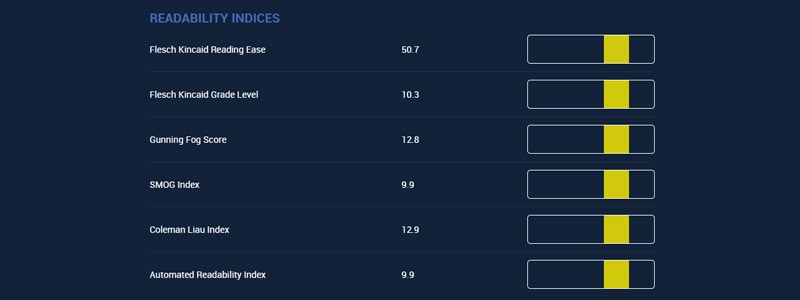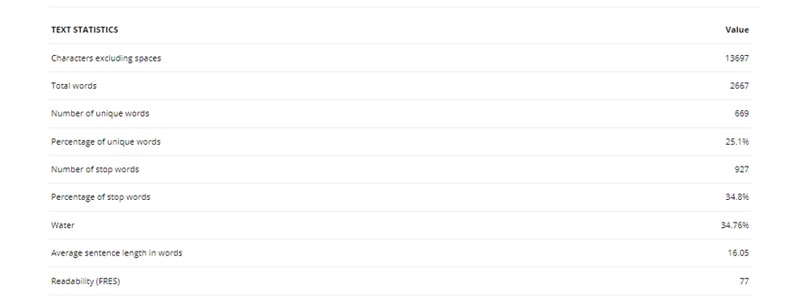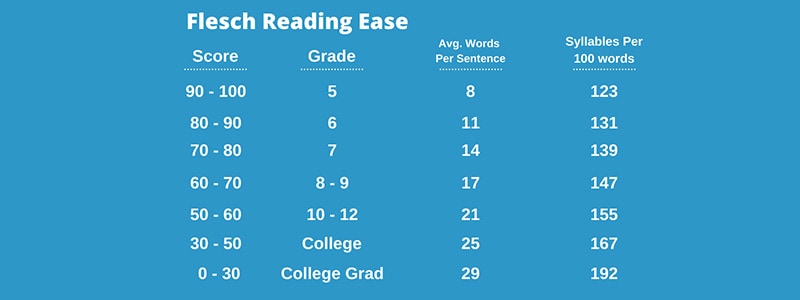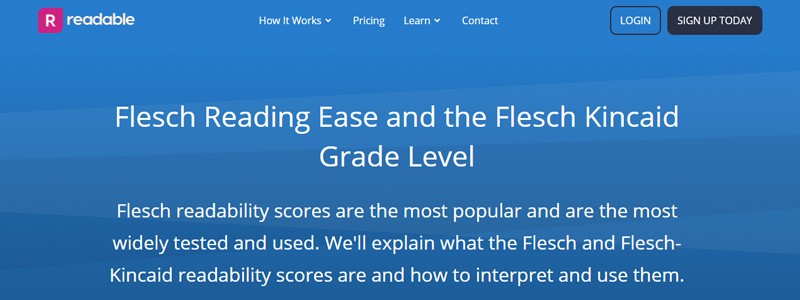Many factors affect the conversion rate of a website, one of the most important being the readability of the content.
Readability is a property that characterizes the perception of the text by the reader. Thus, readability indicators determine how well your way of conveying information, its relevance, section structure, and visual design of texts correspond to the characteristics and needs of the target audience. But, of course, doesn’t it depend on how long the reader will stay on the site and whether he wants to perform the targeted action.
Frequently asked questions from different levels of specialists:
- Do most readability formulas depend on which two elements to evaluate written materials?
- To improve readability in a website, which of the following would be most effective?
The audience expects to see a style and writing style that is acceptable to them. Therefore, in the process of creating text materials, it is important to use readability check tools. They will scan your article, blog, or essay for complex linguistic structures and inappropriate words, estimate the length of sentences, and even count the number of syllables in words. This will allow you to create high-quality, adequate text content that does not need to be rewritten, adapted, or edited.
Let’s take a closer look at the concept of readability and explore the main criteria for evaluating this parameter.
Readability tool
The SEO Checker plugin developed by Plerdy allows you to check the text published on the site quickly. Then, with the help of an online analyzer, you can conduct a full SEO audit of the text, including assessing the readability of the content.

How the tool works
To run a check, activate the SEO Checker extension and enter your text or URL in the fields provided. Click Check – a table with detailed content statistics will appear.
The tool analyzes the text according to the following parameters: total number of characters excluding spaces, number of words, number and percentage of unique and stop words, and average sentence length (in words). The percentage also displays all top words, the amount of “water,” and the Readability Index (FRES).
Upon request, you can select the criteria “Number of unique words” and “Number of stop words” – the tool will find and highlight in blue all these words on your web page.
Website SEO Checker Tool

To check the readability of individual text and get SEO information about a page, it is convenient to use the SEO Checker tool right in the browser. When choosing a screening method, consider how detailed you want to get. For example, by inserting text into a special field, you will have access to the function of highlighting unique and stop words. However, by running the check through the URL, you will only get general statistics.
Plerdy Tracking Code
Need to analyze your content against Google’s ranking criteria? Install the Plerdy tracking code. Using the statistics obtained, you will improve your website and get closer to the first positions in the search engine.
The tool calculates the number of keywords, performs technical SEO testing, and checks the page content for important elements to search engines. Then, based on metrics, you can segment your target audience and develop relevant content for each group.
What is readability?
In simple terms, readability is an indicator of the ease of reading and comprehension of the text. The parameter is influenced by many factors that can be conditionally divided into text and visual content.

The first includes the length and grammatical structure of the sentence, the number of syllables in each word, the percentage of long words about the total volume, etc. However, readability is also influenced by fonts, their color and size, word spacing, and line spacing. Therefore, readability tools can help you identify weaknesses in your content and fix them.
Marketers recommend always focusing on the age of the target audience. It is generally accepted that the average reader has a reading ability that matches that of a 12–14-year-old. Accordingly, the text should be drafted so that readers of this age group understand its meaning. Keep in mind that, statistically, one in ten users may have dyslexia or other cognitive difficulties.
To get an objective measure of readability, use several formulas, which are discussed below. A low readability index (which means it is difficult to understand the text) can be increased by rephrasing and optimizing sentences.
Replace highly specialized terms with simple, straightforward words. Shorten complex and long sentences. Remove the “wateriness” of the text as much as possible, and exclude stop words. These actions will increase the level of readability of the publication.
Readability (Flesch–Kincaid grade level)

To assess the readability of the text, several formulas and test scores are used, each of which is aimed at obtaining certain parameters. Here are the most popular ones:
- Flesch Reading Ease
- Flesch–Kincaid
- SMOG Index
- Gunning Fog Index
- Dale–Chall Formula
Flesch Reading Ease is a service that checks the text for ease of perception. After testing, a score is given from 1 to 100, where 100 means the highest readability. A satisfactory degree of readability is in the 70–80 range, roughly the eighth-grade level. Such text will be understandable to the average user without special knowledge in your field.

The formula for checking the readability of the text was developed more than 70 years ago by writer and consultant Rudolph Flesch. Working to improve the comprehension of Associated Press publications, he formed a text-grading technique still used today. Here is the ratio:
206,835 - 1,015 (total words / total sentences) - 84.6 (total syllables / total words)
or
FRE = 206.835 - 1.015 × ASL - 84.6 × ASW
(ASL – average sentence length, ASW – the average number of syllables per word)
The next formula, the Flesch–Kincaid Index, was developed in collaboration with John P. Kincaid.
0.39 (total words / total sentences) + 11.8 (total syllables / total words) - 15.59
It was originally used for the documentary needs of the US Navy. The index is now used to estimate the approximate reading comprehension level. It shows how many years a person had to go to school to understand the text (according to the American education system).
The SMOG Index (or McLaughlin’s formula) analyzes the number of words in a text consisting of three or more syllables.
SMOG grade = 3 + square root of polysyllable count
Using this formula, a coefficient is calculated that shows how easy a text fragment is to understand. Experts believe that this particular method provides more accurate data than those described above.
The Gunning Fog Index allows you to determine the minimum age of the reader who will understand the text. The Nebula Index measures the difficulty of reading based on the average sentence length and the percentage of words with three or more syllables.
0.4 ((words / sentences) +100 (complex words / words))
Analyze at least two text fragments containing approximately 100 words. The higher the value you get, the harder it is to read the text.
The Dale–Chall Formula is based on the ratio of simple and complex word forms in text fragments of 100 words.
0.1579 (difficult words / words × 100) + 0.0496 (words / sentences)
Professor Edgar Dale teamed up with Jeanne S. Chall to create a vocabulary of 3,000 simple words that fourth graders can understand.
Readability Score
A high score for readability is something that every author who creates texts for publication on the Internet and offline sites should strive for. Practice shows that one of the most popular readability estimates is the Flesch–Kincaid formula described above. This table will help to decipher the received numbers
| Grade | Education level for perception | Readability |
| 90–100 | Grade 5 | Very easy to read. Can be understood by 11-year-olds. |
| 80–90 | 6th grade | Easily. Colloquial. Suitable for communicating with clients. |
| 70–80 | 7th grade | Easy enough to read |
| 60–70 | 8th or 9th grade | Still simple language. Can be understood by 13–15-year-old teenagers. |
| 50–60 | 10th–12th grades | The text is harder to read |
| 30–50 | College student | Difficult to read and understand |
| 0–30 | College graduate | Very difficult. Information is clear to university graduates. |
It is believed that the average American reads (and perceives) something like an eighth-grade student. Therefore, when creating content, it is advisable to select vocabulary and grammatical constructions that will be understandable to a 7th–9th-grade student.
However, this benchmark does not correlate in any way with the education and intellectual development of your audience. Also, we are not talking about using a small vocabulary and poor speech. Instead, focus on giving preference to simple, concise sentences – without unnecessary phrases and stylistic figures.
If the material is intended for a wide audience, avoid narrowly focused terms, jargon, and professional terminology. By simplifying the text and making it more informative, you will get a high readability score for a good audience experience.
Readability in Microsoft Word
You can check the text or part of it for readability right in Microsoft Word. However, readability is not automatically assessed and must be enabled in conjunction with spelling and grammar checking.
To do this, go to the “File” tab, select “Options” > “Spelling,” and check the box next to the “Check for legibility” function. If there are any errors or typos, you must first correct them. Then a window will open in which the readability level calculated according to the Flesch and Flesch–Kincaid formulas will be displayed.
Output
The readability score is an important factor that affects a site’s conversion, ranking in search engines, and effective promotion on the Internet. A good level of readability ensures that the reader will correctly understand your message and will be able to grasp its essence without time and effort. All of this greatly increases the chances that the reader will become your client.
For a high level of readability score, use the information style in your presentation. Avoid complex sentences, high-flown words, and special vocabulary – these all negatively affect the readability of the text. The more simply a thought is formulated, the better it will be understood by your target audience.
